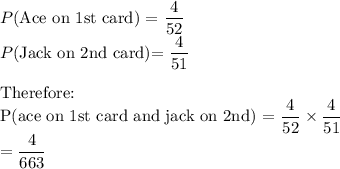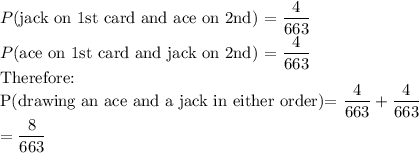
Mathematics, 25.06.2020 02:01 dedrell16
The following question involves a standard deck of 52 playing cards. In such a deck of cards there are four suits of 13 cards each. The four suits are: hearts, diamonds, clubs, and spades. The 26 cards included in hearts and diamonds are red. The 26 cards included in clubs and spades are black. The 13 cards in each suit are: 2, 3, 4, 5, 6, 7, 8, 9, 10, Jack, Queen, King, and Ace. This means there are four Aces, four Kings, four Queens, four 10s, etc., down to four 2s in each deck.
You draw two cards from a standard deck of 52 cards without replacing the first one before drawing the second. (a) Are the outcomes on the two cards independent? Why?
1. No. The events cannot occur together. 2. Yes. The events can occur together. 3. No. The probability of drawing a specific second card depends on the identity of the first card. 4. Yes. The probability of drawing a specific second card is the same regardless of the identity of the first drawn card.
(b) Find P(ace on 1st card and jack on 2nd). (Enter your answer as a fraction.)
(c) Find P(jack on 1st card and ace on 2nd). (Enter your answer as a fraction.)
(d) Find the probability of drawing an ace and a jack in either order. (Enter your answer as a fraction.)

Answers: 1


Another question on Mathematics



Mathematics, 21.06.2019 21:50
Aline passes through the point (–7, 5) and has a slope of 1/2 which is another point that the line passes through?
Answers: 3

You know the right answer?
The following question involves a standard deck of 52 playing cards. In such a deck of cards there a...
Questions




History, 26.07.2019 06:00



Chemistry, 26.07.2019 06:00


Mathematics, 26.07.2019 06:00


Geography, 26.07.2019 06:00



Social Studies, 26.07.2019 06:00


History, 26.07.2019 06:00


Health, 26.07.2019 06:00







